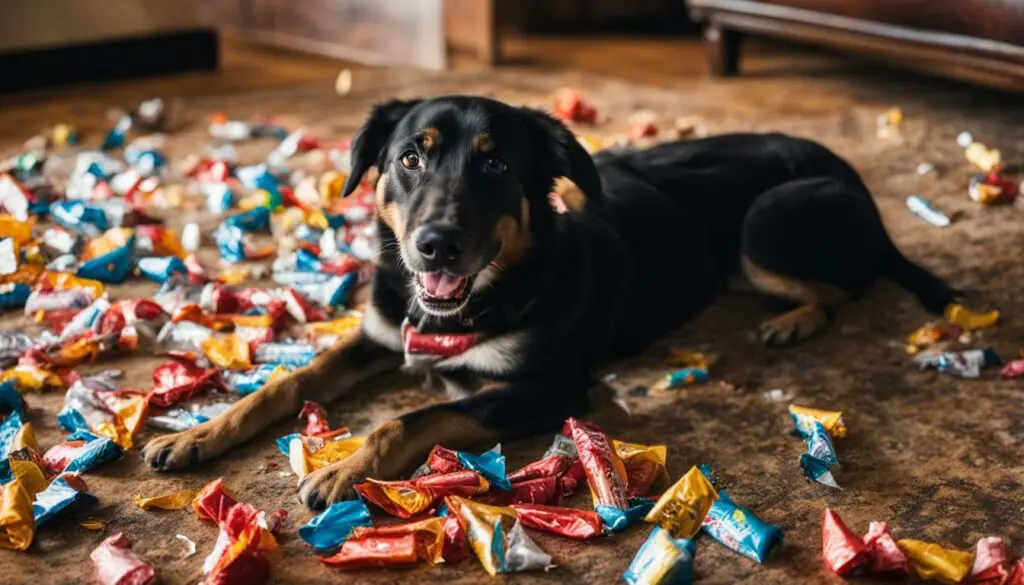If your dog has ingested a candy wrapper, it can be a cause for concern. In this article, I will provide guidance on what steps to take if your dog ingests a candy wrapper, including potential consequences and how to prevent it from happening in the future.
Key Takeaways:
- Take immediate action if your dog eats a candy wrapper to prevent potential health complications.
- Monitor your dog for signs of distress or digestive issues after ingesting a candy wrapper.
- Contact your veterinarian for guidance and evaluation if necessary.
- Practice responsible pet ownership by keeping candies and wrappers out of your dog’s reach.
- Spread awareness about the dangers of dogs ingesting candy wrappers to prevent similar incidents.
The Potential Risks and Consequences of Dogs Eating Candy Wrappers
When it comes to dogs eating candy wrappers, the potential risks and consequences can be quite concerning. Candy wrappers, especially those containing chocolate or toxic substances like xylitol, can pose hazards to dogs’ health. It’s essential to be aware of these risks and take immediate action if your dog ingests a candy wrapper.
Ingesting a candy wrapper can lead to digestive issues and blockages in dogs. The wrapper may cause obstructions in the gastrointestinal tract, leading to symptoms such as vomiting, decreased appetite, tiredness, and straining to poop. If left untreated, these complications can have serious consequences for your furry friend.
Toxic substances found in some candy wrappers, like chocolate and xylitol, can be extremely harmful to dogs. Chocolate can cause poisoning in dogs, affecting their cardiovascular and nervous systems. Xylitol, commonly found in sugar-free candies, can lead to a rapid drop in blood sugar levels and liver toxicity. These substances require immediate veterinary attention to prevent severe health complications.
Table: Hazards of Dogs Eating Candy Wrappers
| Hazard | Description |
|---|---|
| Obstruction | Ingested wrappers can cause blockages in the digestive system, leading to vomiting, discomfort, and potential surgical intervention. |
| Chocolate Toxicity | Chocolate contains theobromine and caffeine, which are toxic to dogs. Ingestion can result in symptoms like increased heart rate, tremors, and even seizures. |
| Xylitol Poisoning | Xylitol, commonly found in sugar-free candies, can cause a rapid drop in blood sugar levels and liver toxicity in dogs. It requires immediate veterinary attention. |
Prevention plays a crucial role in keeping dogs safe from the hazards of candy wrappers. Ensure that candies and treats are stored securely and out of reach. Dispose of wrappers properly to avoid easy accessibility. Additionally, training your dog to respond to commands like “leave it” can deter them from approaching and consuming potentially dangerous items.
By understanding the potential risks and consequences of dogs eating candy wrappers and taking proactive measures to prevent such incidents, you can help safeguard your furry friend’s well-being and promote responsible pet ownership.
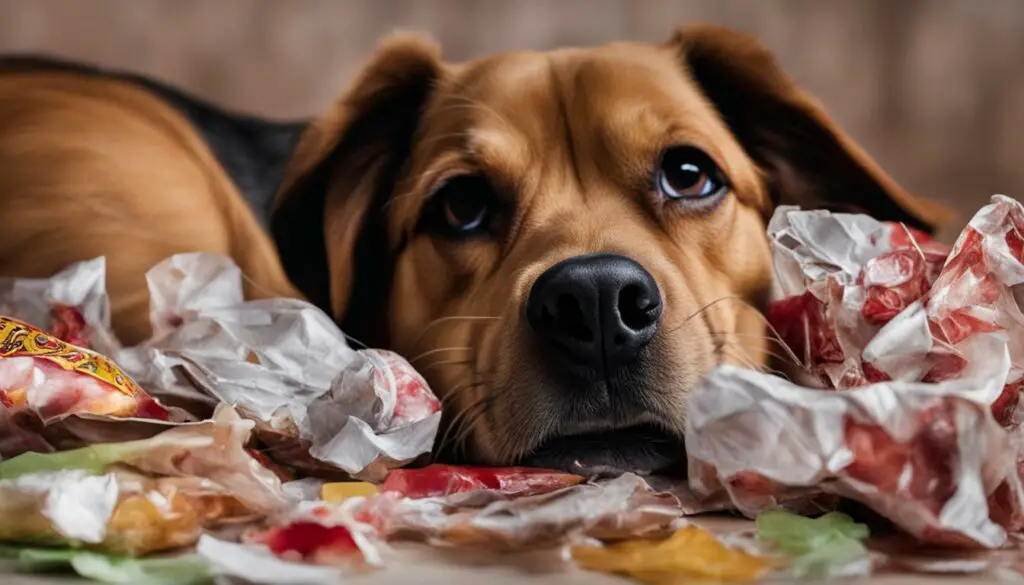
Recognizing the Signs of a Dog Eating a Candy Wrapper
When it comes to dogs consuming candy wrappers, it’s essential to be able to recognize the signs and symptoms that may indicate a potential problem. By being aware of these indicators, you can take prompt action and ensure the well-being of your furry friend.
Some common signs that your dog may have eaten a candy wrapper include:
- Vomiting
- Decreased appetite
- Tiredness or lethargy
- Straining to poop
- Presence of the wrapper in the stool
If you notice any of these symptoms, it’s crucial to monitor your dog closely and seek veterinary attention if necessary. These signs can be indicative of a potential blockage or digestive issue caused by the ingestion of a candy wrapper.
It’s important to note that not all dogs may exhibit these symptoms, and some dogs may not show any signs at all. Therefore, it’s always better to err on the side of caution and consult with your veterinarian if you suspect your dog has consumed a candy wrapper.
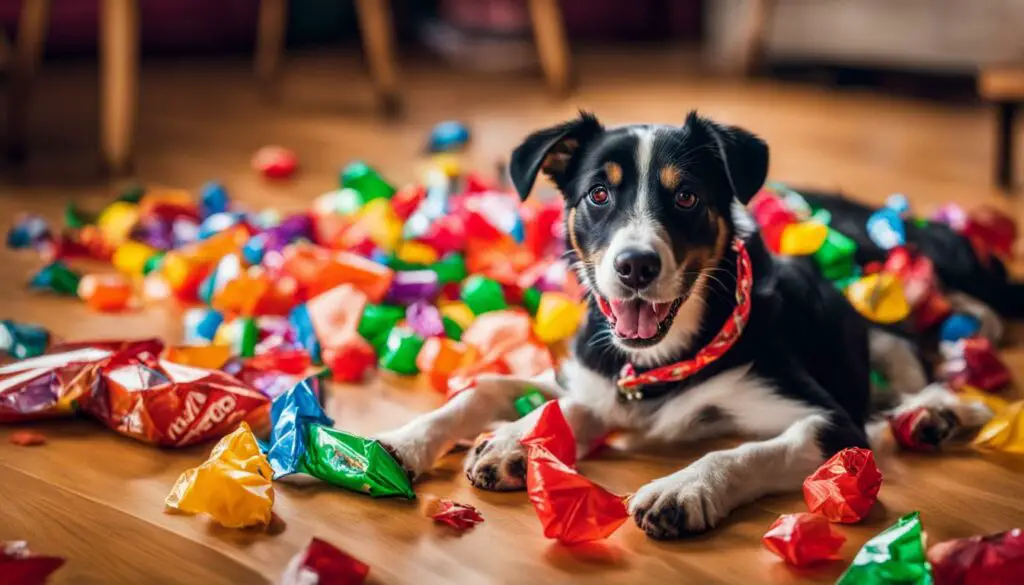
Prevention is Key
While it’s crucial to recognize the signs of a dog eating a candy wrapper, it’s equally important to take preventive measures to avoid such incidents altogether. By implementing the following strategies, you can minimize the risk of your dog ingesting a candy wrapper:
- Keep all candies and treats out of your dog’s reach, preferably in pet-proof containers.
- Dispose of candy wrappers properly and securely.
- Train your dog to respond to commands such as “leave it” to discourage them from approaching or consuming potential hazards.
By taking these preventive measures, you can create a safe environment for your dog and reduce the chances of candy wrapper ingestion.
Remember, being proactive and attentive to your dog’s behavior can go a long way in protecting them from potential harm. If you suspect your dog has consumed a candy wrapper or if you have any concerns, don’t hesitate to reach out to your veterinarian for guidance.
What to Do When Your Dog Ingests a Candy Wrapper
If you discover that your dog has ingested a candy wrapper, it’s important to take immediate action to ensure their safety. Here’s a step-by-step guide on what to do:
- Stay calm: While it’s natural to feel worried, it’s important to stay calm and focused. Panicking can make the situation more stressful for both you and your dog.
- Assess the situation: Determine the type of candy wrapper your dog has ingested and the quantity. If it contained chocolate or toxic substances like xylitol, the situation may be more serious and require immediate veterinary attention. It’s also important to observe your dog for any signs of distress or discomfort.
- Contact your veterinarian: If your dog has ingested a candy wrapper and you’re unsure of the potential risks, it’s best to contact your veterinarian or an emergency vet for guidance. They will be able to evaluate the situation and provide you with specific instructions based on your dog’s breed, size, and the type of wrapper consumed.
- Follow veterinary advice: Your veterinarian may instruct you to induce vomiting or observe your dog for any symptoms. It’s important to follow their advice closely and provide any necessary information about the candy wrapper ingested. They may recommend bringing your dog in for an examination or monitoring them at home depending on the severity of the situation.
Remember, every situation is unique, and it’s crucial to consult with a professional to determine the best course of action for your dog. Acting promptly and seeking veterinary guidance will help ensure the well-being of your furry friend.
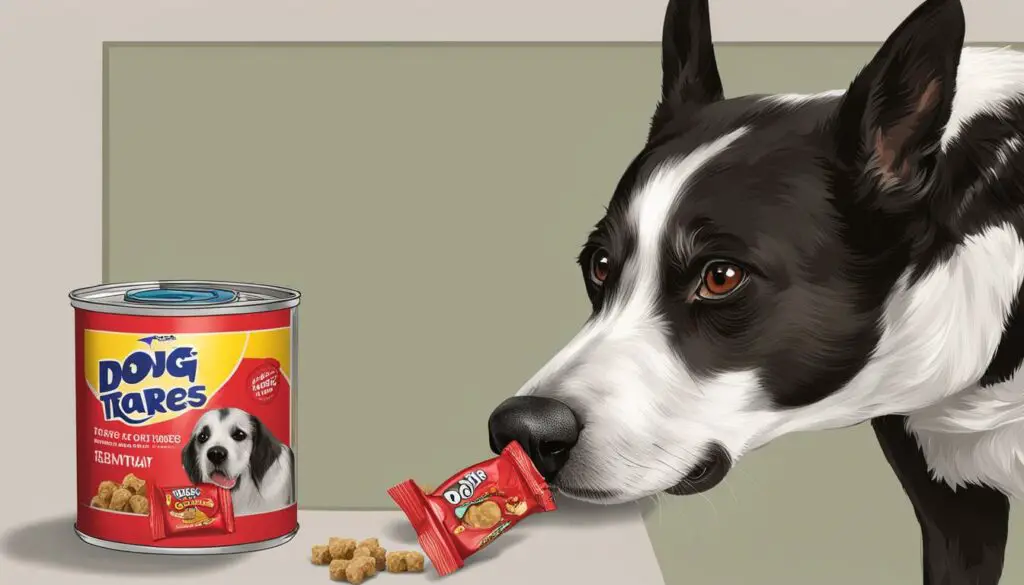
Table: Common Signs of Candy Wrapper Ingestion
| Signs to Watch for | Description |
|---|---|
| Vomiting | Frequent or persistent vomiting may indicate that the candy wrapper is causing digestive issues. |
| Decreased Appetite | If your dog suddenly loses interest in food or refuses to eat, it could be a sign of an underlying problem. |
| Tiredness or Lethargy | If your dog seems unusually tired or weak, it may be a result of the candy wrapper ingestion affecting their energy levels. |
| Straining to Poop | Difficulty or discomfort while defecating could indicate a blockage caused by the candy wrapper. |
| Presence of Wrapper in Stool | Finding undigested candy wrapper material in your dog’s stool is a clear indication of ingestion. |
Veterinary Care for Dogs Who Ate Candy Wrappers
If your dog has consumed a candy wrapper, it is crucial to seek veterinary care immediately. A veterinarian will be able to assess the situation, provide appropriate treatment, and monitor your dog’s condition to ensure their safety and well-being.
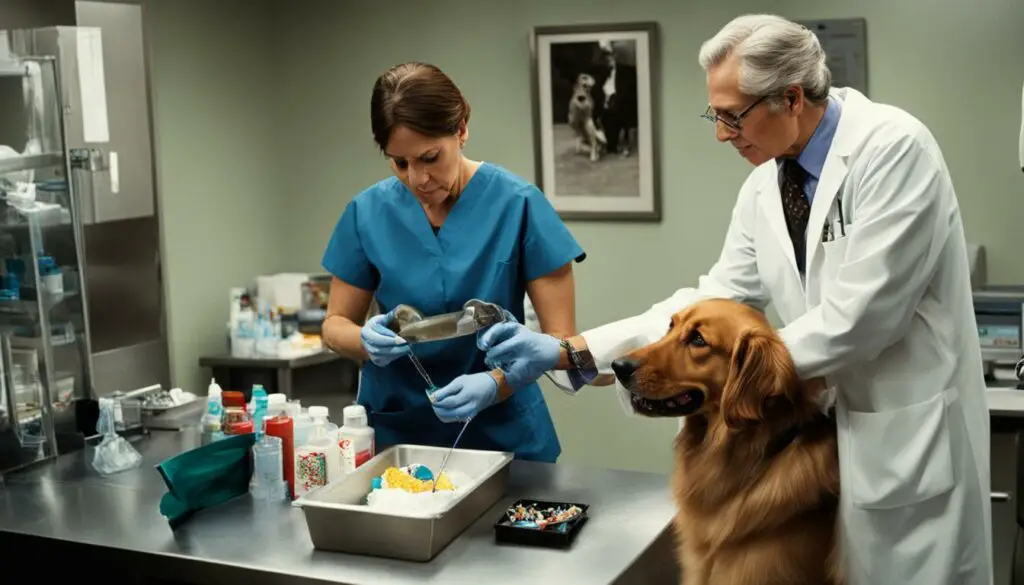
During the veterinary evaluation, the veterinarian may perform tests such as X-rays to determine if there are any blockages or other complications caused by the ingestion of the candy wrapper. These tests can provide valuable information for the veterinarian to make an accurate diagnosis and develop a suitable treatment plan.
In some cases, the veterinarian may recommend inducing vomiting to remove the candy wrapper from your dog’s system. This procedure should only be performed under the guidance of a veterinarian to ensure it is done safely and effectively.
Additionally, the veterinarian may provide supportive care such as fluids, medications, or dietary adjustments to help your dog recover from the ingestion and prevent any further complications. They will also provide you with instructions on how to monitor your dog’s condition at home and when to schedule a follow-up appointment.
Table: Veterinary Care for Dogs Who Ate Candy Wrappers
| Treatment | Description |
|---|---|
| Evaluation | Veterinarian assesses the situation, performs tests if necessary, and makes a diagnosis. |
| Inducing Vomiting | If appropriate, the veterinarian may induce vomiting to remove the candy wrapper. |
| Supportive Care | Fluids, medications, and dietary adjustments may be provided to support your dog’s recovery. |
| Monitoring | The veterinarian will provide instructions on monitoring your dog’s condition at home and schedule a follow-up appointment if needed. |
Remember, seeking veterinary care promptly is essential to ensure the best possible outcome for your dog. Do not hesitate to contact your veterinarian if you have any concerns or questions regarding your dog’s health after ingesting a candy wrapper.
Potential Surgical Solutions for Dogs with Candy Wrapper Obstructions
If a dog ingests a candy wrapper and experiences a bowel obstruction, surgical intervention may be necessary to resolve the issue. Surgery becomes an option when the blockage is severe and causing discomfort or if the dog displays symptoms such as vomiting, abdominal pain, or an inability to pass stool.
The surgical procedure aims to remove the candy wrapper or any other foreign object causing the obstruction. The veterinarian will perform an examination, possibly including X-rays, to determine the exact location and size of the blockage. Based on the findings, they will decide on the most appropriate surgical technique.
During the surgery, the veterinarian will make an incision in the dog’s abdomen to access the gastrointestinal tract. They will then carefully remove the obstruction and assess the condition of the surrounding tissues. After ensuring that no other objects remain in the digestive system, the incision will be closed, and the dog will be monitored during the recovery period.
| Procedure | Estimated Cost |
|---|---|
| Exploratory Laparotomy | $1,000 – $3,000 |
| Endoscopy | $500 – $2,000 |
Note: The estimated costs can vary depending on the veterinarian’s experience, the severity of the obstruction, additional procedures required, and geographical location.
After the surgery, the veterinarian will provide instructions for post-operative care, including pain management, wound care, and dietary recommendations. It’s crucial to follow these instructions carefully to ensure the dog’s successful recovery.
Preventing dogs from accessing candy wrappers and other hazardous objects is the best way to avoid the need for surgery. Keeping all candies and treats out of reach, properly disposing of candy wrappers, and training your dog to avoid potentially dangerous items can help minimize the risk of ingestion.
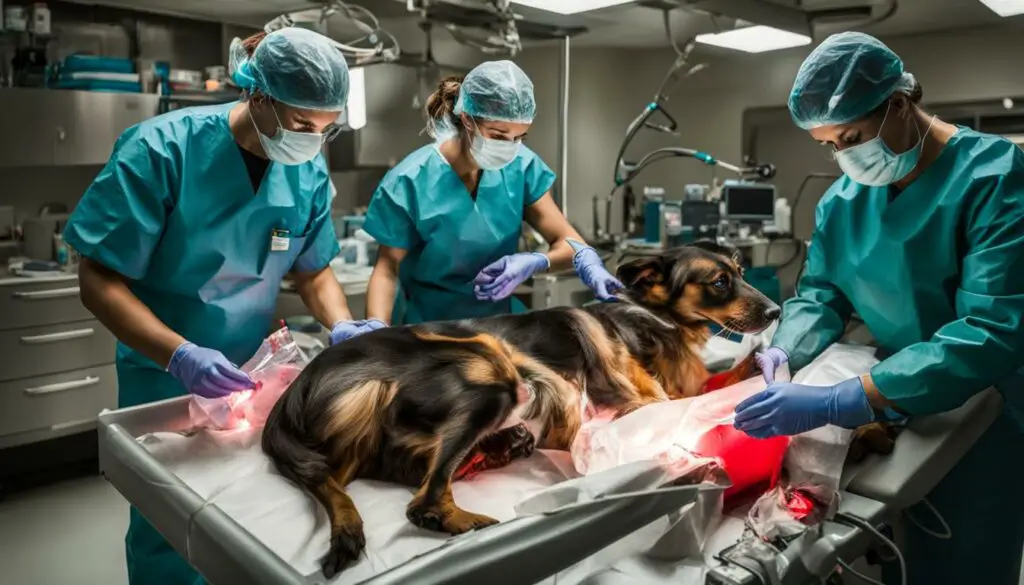
Preventing Dogs from Ingesting Candy Wrappers
In order to protect your furry friend from the dangers of ingesting candy wrappers, it’s important to take proactive measures. By following these guidelines, you can significantly reduce the risk of your dog consuming potentially harmful wrappers.
- Store all candies and treats in pet-proof containers that are out of your dog’s reach.
- Dispose of candy wrappers properly and securely, ensuring they are placed in a sealed trash can or recycling bin.
- Train your dog to respond to commands such as “leave it” to discourage them from approaching or consuming potentially dangerous items.
- Keep an eye on your dog during festive occasions or gatherings where candy wrappers may be more prevalent.
By being vigilant and implementing these preventative measures, you can create a safe environment for your dog and minimize the chances of them ingesting candy wrappers.
Recognizing the Importance of Pet-Proof Containers
Investing in pet-proof containers can be a game-changer in preventing your dog from accessing candy wrappers. These containers are designed to be secure and difficult for pets to open, keeping the treats and wrappers safely out of reach. Look for options with tightly sealed lids or even childproof locks to ensure the utmost safety for your furry friend.
Additionally, consider using containers that are specifically marketed as pet-proof. These containers are often made of durable materials that can withstand your dog’s attempts to open them. They are designed with the specific needs of pet owners in mind, providing a reliable solution to keep candies and wrappers inaccessible to curious canines.
| Pet-Proof Container Options | Features |
|---|---|
| Airtight Plastic Containers | Sealed lids to keep odors and treats contained |
| Lockable Treat Jars | Childproof locks or latches to prevent easy access |
| Stainless Steel Canisters | Durable construction that withstands chewing or scratching |
Investing in the right pet-proof containers can go a long way in ensuring the safety of your dog and providing you with peace of mind.
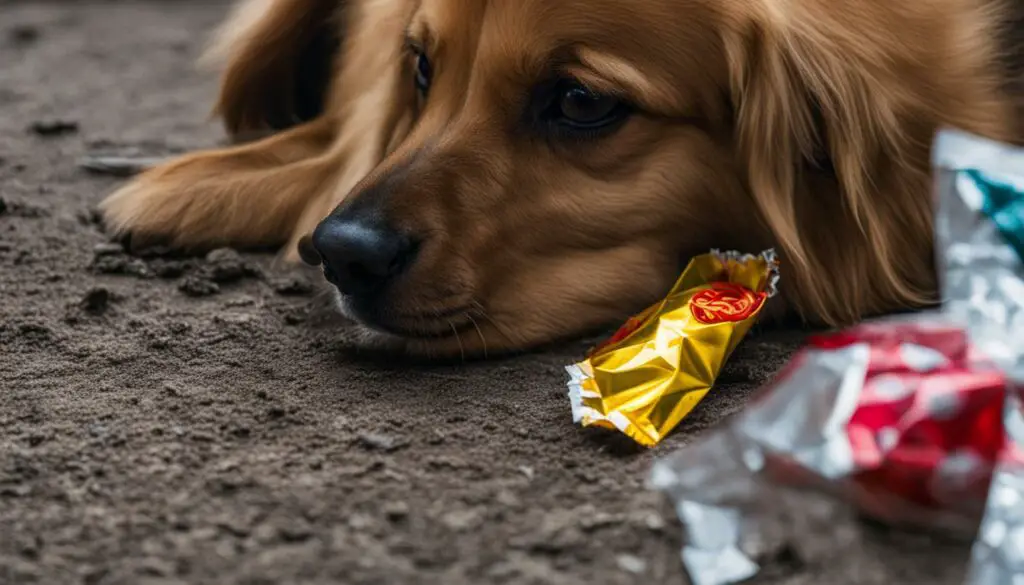
The Dangers of Certain Candies for Dogs
When it comes to keeping our furry friends safe, it’s essential to be aware of the dangers that certain candies pose to dogs. While many of us enjoy indulging in sweet treats, it’s important to remember that some candies can be toxic and even life-threatening to our canine companions.
One of the most hazardous candies for dogs is chocolate. Chocolate contains theobromine, a substance that dogs cannot metabolize effectively. Even small amounts of chocolate can cause symptoms such as vomiting, diarrhea, rapid breathing, and even seizures. The darker the chocolate, the higher the concentration of theobromine, making it even more dangerous for dogs to consume.
Another candy ingredient that poses a significant risk to dogs is xylitol. This sugar substitute is commonly found in sugar-free candies, gum, and even some baked goods. Xylitol can cause a rapid release of insulin in dogs, leading to a dangerous drop in blood sugar levels. Symptoms of xylitol toxicity include weakness, tremors, seizures, and liver failure.
| Candy Type | Danger Level |
|---|---|
| Chocolate | High |
| Sugar-free candies with xylitol | High |
| Candies with nuts or raisins | Moderate |
| Candy wrappers | Low |
Other candies that can pose a risk to dogs include those that contain nuts or raisins. Nuts, such as macadamia nuts, can cause weakness, tremors, and difficulty walking in dogs. Raisins, commonly found in some candies, can be toxic and lead to kidney failure.
As a responsible pet owner, it’s crucial to educate yourself about the dangers of certain candies for dogs and take appropriate measures to keep them out of your dog’s reach. By being vigilant and keeping these hazardous candies safely stored away, you can help protect your furry friend from the potential dangers they may pose.
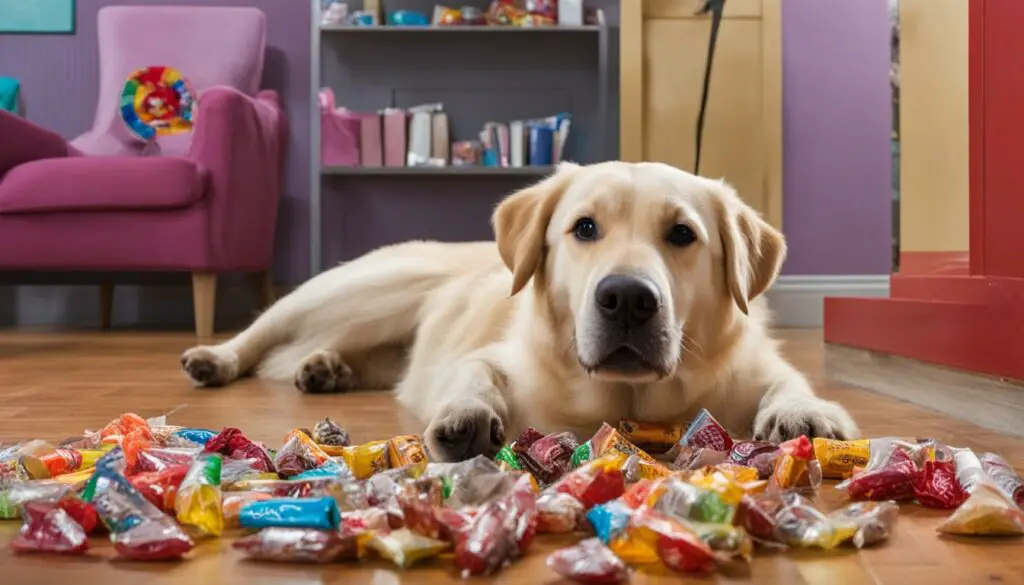
Handling Chocolate and Xylitol Toxicity in Dogs
When it comes to emergency situations involving dogs eating candy wrappers, two substances pose significant risks: chocolate and xylitol. Chocolate toxicity can occur when dogs consume chocolate in any form, and xylitol is a toxic substance commonly found in sugar-free candies and gum. Both can have severe consequences for a dog’s health and require immediate action.
Chocolate contains theobromine and caffeine, which are toxic to dogs. The severity of the toxicity depends on the type and amount of chocolate ingested. Dark chocolate and baking chocolate have higher levels of theobromine and are more dangerous than milk chocolate. Symptoms of chocolate toxicity include vomiting, diarrhea, rapid breathing, increased heart rate, tremors, and in severe cases, seizures. If you suspect your dog has ingested chocolate, contact your veterinarian or a pet poison helpline immediately.
Xylitol is a sugar substitute often used in sugar-free candies, gum, and other products. It can cause a rapid release of insulin in dogs, leading to hypoglycemia (low blood sugar). Xylitol toxicity can occur even with small amounts of the substance, and symptoms can develop rapidly, typically within 15 to 30 minutes. Signs of xylitol poisoning in dogs include vomiting, lethargy, lack of coordination, seizures, and in severe cases, liver damage. If you suspect your dog has ingested xylitol, seek immediate veterinary care.
“Both chocolate and xylitol can have serious health consequences for dogs, so it’s crucial to act quickly and seek professional help,” says Dr. Sarah Miller, a veterinarian with expertise in toxicology. “Prompt intervention can make a significant difference in the outcome and increase the chances of a full recovery.”
If your dog has ingested chocolate, your veterinarian may recommend inducing vomiting if it has been within the last two hours. However, not all cases are suitable for inducing vomiting, so it’s essential to consult a professional before attempting this at home. Treatment for chocolate toxicity may also involve administration of activated charcoal to bind the toxins in the stomach, intravenous fluids to support hydration and flush out toxins, and medications to control symptoms.
In the case of xylitol toxicity, time is of the essence. Quick action is necessary to prevent the rapid release of insulin and subsequent hypoglycemia. Your veterinarian may need to induce vomiting, administer intravenous dextrose to elevate blood sugar levels, monitor liver function, and provide supportive care. The prognosis for dogs with xylitol toxicity depends on the amount ingested and the rapidity of treatment.
| Chocolate | Xylitol |
|---|---|
| Milk Chocolate: 1 ounce per 1 pound of body weight | As little as 0.1 gram per kilogram of body weight |
| Semi-Sweet Chocolate: 1 ounce per 3 pounds of body weight | |
| Baking Chocolate: 1 ounce per 9 pounds of body weight |
Prevention is key to avoiding these emergencies. Keep all chocolates and candies containing xylitol securely stored in a location inaccessible to your dog. Be mindful when disposing of candy wrappers, ensuring they are properly sealed and disposed of in a container your dog cannot access. Educate yourself and others about the dangers of chocolate and xylitol to help create a safer environment for dogs.
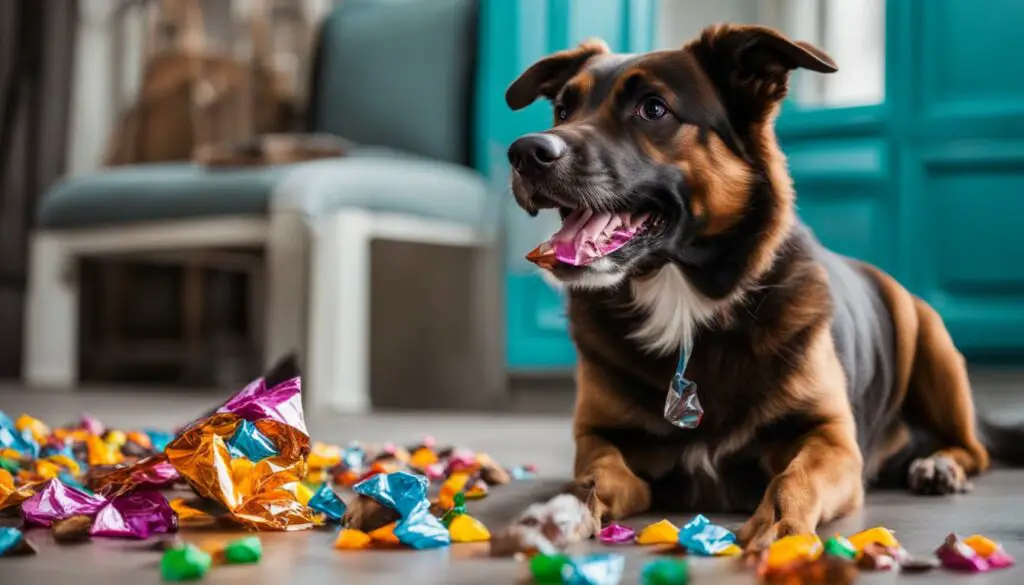
Spreading Awareness and Educating Others on the Dangers
As a responsible pet owner, I believe it is crucial to spread awareness about the dangers of dogs consuming candy wrappers. By educating ourselves and others, we can prevent unnecessary harm to our beloved furry friends. It is our responsibility to ensure their safety and well-being.
One way to educate others is by sharing our knowledge with family, friends, and community members. By informing them about the potential risks and consequences of dogs eating candy wrappers, we can help prevent similar incidents from occurring. Together, we can create a safer environment for dogs everywhere.
In addition to raising awareness, we should also emphasize the importance of responsible pet ownership. This includes keeping all candies and treats out of our dog’s reach, preferably in pet-proof containers. By properly disposing of candy wrappers and training our dogs to respond to commands like “leave it,” we can discourage them from approaching or consuming potentially dangerous items.
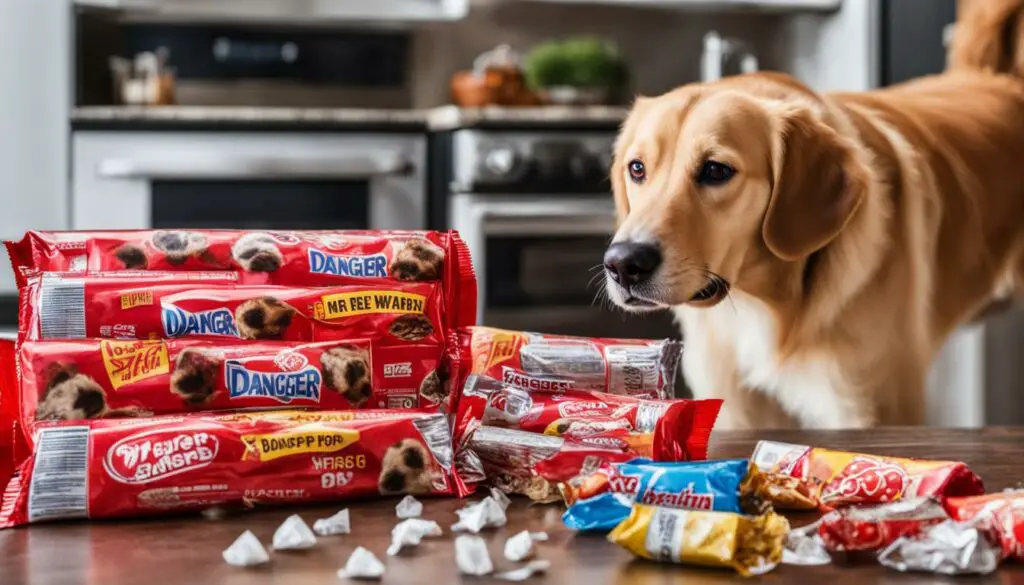
The Importance of Knowledge and Action
“Education is the key to prevention. By spreading awareness and educating others, we can help keep our furry friends safe from the dangers of candy wrappers.” – [Your Name]
It’s crucial to understand which types of candies are hazardous for dogs and to recognize the signs of a dog ingesting a candy wrapper. By being knowledgeable about these risks, we can respond swiftly and appropriately if our dog consumes a wrapper. Seeking veterinary care and following their guidance is essential to ensure our dog’s health and well-being.
Let’s take the lead in promoting responsible pet ownership and educating others about the dangers of dogs consuming candy wrappers. Together, we can create a community that prioritizes the safety and happiness of our four-legged companions.
Conclusion
If your dog has ingested a candy wrapper, it’s crucial to take immediate action to ensure their safety. Remember, prevention is key, so always keep candies and wrappers out of your dog’s reach. By being vigilant and responsible, you can help protect your furry friend from the dangers of candy wrappers.
If your dog consumes a candy wrapper, contact your veterinarian right away for guidance on what steps to take. They will be able to assess the situation and provide appropriate treatment if necessary. Remember to watch for any signs of distress or complications, and don’t hesitate to seek professional help.
Spread awareness about the risks associated with dogs consuming candy wrappers. Educate your family, friends, and community on the importance of responsible pet ownership. By sharing your knowledge, you can help prevent similar incidents from happening and safeguard the well-being of dogs everywhere.
FAQ
What should I do if my dog eats a candy wrapper?
If your dog ingests a candy wrapper, it’s important to take immediate action. Assess the situation, monitor your dog for any signs of distress, and contact your veterinarian or an emergency vet for guidance.
What are the potential risks of dogs eating candy wrappers?
Candy wrappers can cause digestive issues and blockages in dogs. Ingesting a wrapper, especially if it contains chocolate or toxic substances like xylitol, can lead to serious health complications.
How can I recognize if my dog has eaten a candy wrapper?
Common signs that your dog may have eaten a candy wrapper include vomiting, decreased appetite, tiredness, straining to poop, and the presence of the wrapper in the stool.
What should I do if my dog ingests a candy wrapper?
If your dog eats a candy wrapper, take immediate action by contacting your veterinarian or an emergency vet for guidance. They can assess the situation and provide appropriate treatment if necessary.
Do dogs require veterinary care if they eat a candy wrapper?
In many cases, a veterinary evaluation is necessary if your dog consumes a candy wrapper. A veterinarian can perform tests, provide treatment, and determine if surgery is needed to remove a potential blockage.
How can I prevent my dog from eating candy wrappers?
To prevent your dog from ingesting candy wrappers, keep all candies and treats out of reach in pet-proof containers. Dispose of wrappers properly, train your dog to respond to commands like “leave it,” and be aware of the candies that pose a greater risk.
What candy types are hazardous for dogs?
Certain candies like chocolate, sugar-free candies containing xylitol, nuts, raisins, and the candy wrappers themselves can be hazardous for dogs if ingested.
How should I handle chocolate and xylitol toxicity in dogs?
If your dog ingests chocolate or candies containing xylitol, it’s crucial to act quickly. Contact your veterinarian or a pet poison helpline for guidance on inducing vomiting or providing appropriate treatment.
How can I spread awareness about the dangers of candy wrappers for dogs?
As a responsible pet owner, educate yourself and others about the risks associated with dogs consuming candy wrappers. Share your knowledge with family, friends, and community members to prevent similar incidents from occurring.
Source Links
- https://be.chewy.com/pet-ate-candy-wrapper-what-to-do/
- https://peteducate.com/my-dog-ate-a-candy-wrapper/
- https://www.eastvalleyanimal.com/what-to-do-if-your-dog-eats-halloween-candy/

